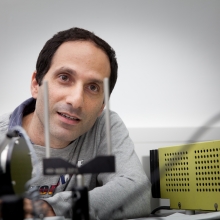The immune system’s battle of the bulge
Briefs

L-R: Prof. Eran Elinav and Prof. Ido Amit
Obesity has long been known to contribute to metabolic conditions like type 2 diabetes, and to increase the risk of Alzheimer’s disease and certain types of cancer. However, it was only recently that scientists discovered that, as levels of obesity increase, immune cells accumulate in adipose (fat) tissues. Such cells have characteristics distinct from those of immune cells that circulate in the blood.
Now, Profs. Amit and Elinav have identified a previously unrecognized immune cell population that accumulates in fat tissues. They demonstrated how, in these cells, a surface receptor called Trem2 serves as a master regulator for molecular dynamics that, in obese individuals, can lead to disease.
“Using single-cell genomic techniques, we generated an atlas of all the types of immune cells that accumulate in adipose tissue and discovered something entirely new: Lipid Associated Macrophages, or LAMs,” says Prof. Amit. “We showed that, in obese individuals, LAMs regulate fat cells, preventing them from growing abnormally large. They also help control the elevation of metabolic indicators like serum insulin, blood cholesterol, and glucose intolerance.”
Trem2—a receptor that allows LAMs to sense pathology in fat cells—acts as an ‘on-off’ switch for this immune cell population’s protective function, says Prof. Elinav.
“Examining obese mice genetically altered to lack the Trem2 receptor, we found that—when LAMs could no longer interact with the adipose tissue—body pathology from fat dramatically increased,” he says, adding that these same mice displayed overgrowth of individual fat cells, along with unhealthy levels of blood sugar and cholesterol. The scientists’ work revealed how, when the Trem2 receptor is present and functioning normally, LAMs help control such obesity-associated symptoms.
“Having identified this immune cell population and its function, it may eventually become possible to design drugs that strengthen its activity, and thereby lessen the severity of obesity-related symptoms,” Prof. Elinav says. “Eventually, this could lead to medical interventions aimed at mediating metabolic disorders, or even breaking the connection that exists between obesity, Alzheimer’s, and cancer.”
The present study adds to excitement generated by a recent Weizmann Institute discovery in which Prof. Amit, together with Prof. Michal Schwartz of the Department of Neurobiology, showed how the Trem2 receptor plays a role in protecting the brain against the ravages of neurodegenerative disease.








